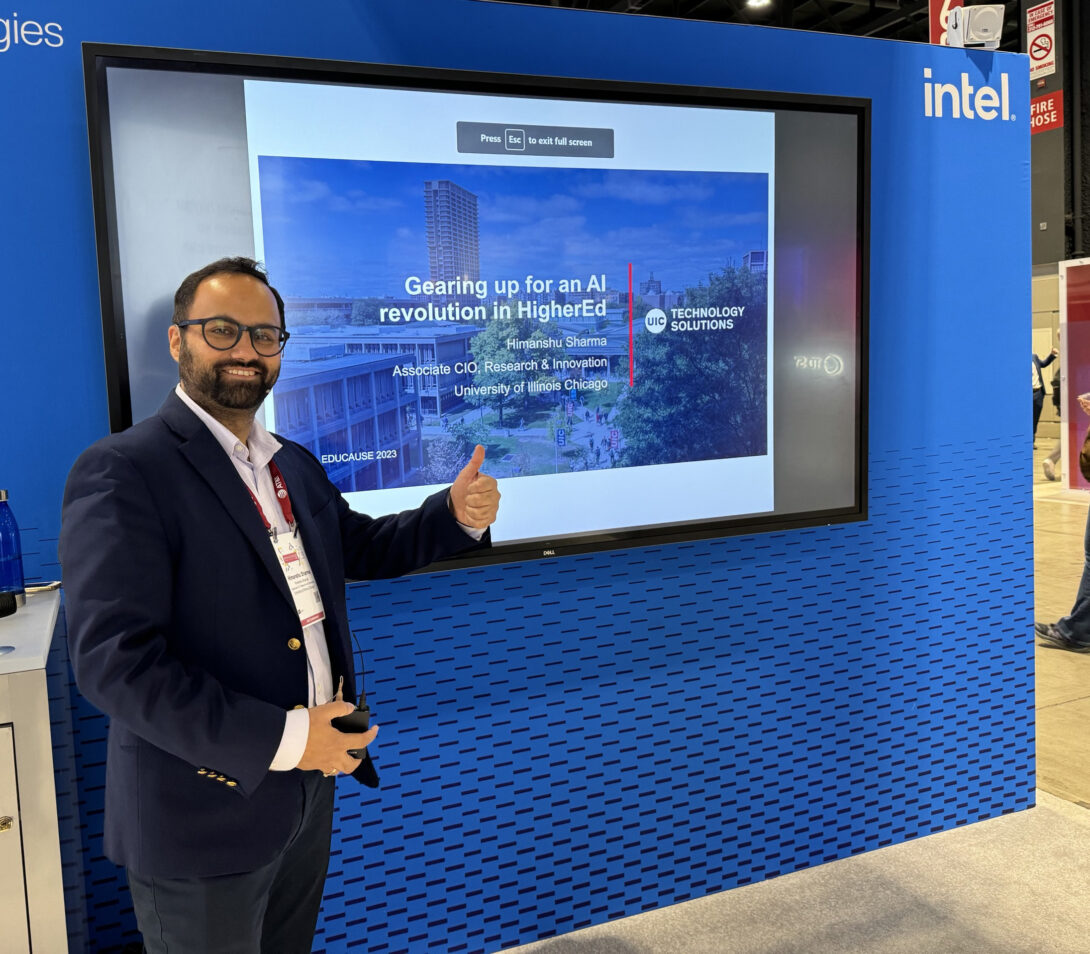Expanding Research Capabilities at UIC: An Interview with Associate CIO for Research Tech & Innovation

Introduction
In higher education, research is central to innovation, addressing complex challenges and expanding the frontiers of knowledge. As we navigate a rapidly evolving world, sustained and strategic research funding remains paramount, ensuring that universities maintain their pivotal role as generators of transformative breakthroughs, shaping the collective future through ongoing innovation.
Committed to furthering UIC’s research ambitions, Associate CIO for Research Technologies & Innovation at Advanced Cyberinfrastructure for Education & Research (ACER), Himanshu Sharma and his team strive to provide researchers and their collaborators around the globe with a broad array of computational resources and data-related services to meet any and all of their technical needs.
These services include providing access to high-performance computing clusters, big data analytics clusters, collaborative research data storage, high-performance networking, and secure research environments. ACER also consults researchers on a broad range of research aims.
In this spotlight interview with UIC Technology Solutions' Marketing & Communications Strategist Anthe Mitrakos, Sharma highlights UIC research news, and talks about his team’s work to expand research funding.
Quote 2
UIC is growing when it comes to research activity. This requires people in a position like ours to be on the lookout and see what’s on the horizon, and that takes investing in time with external stakeholders.
| Associate CIO, Research & Innovation
Spotlight Interview with UIC ACIO, Research & Innovation Himanshu Sharma

Anthe Mitrakos: How do you envision the role of technology evolving in university research?
Himanshu Sharma: The UIC research portfolio has been growing consistently. We have seen roughly a 49% increase in federal research funding over the last five years from 2018 to 2023. This has for the very first time put UIC across the $500 million research funding mark.
Technology has played a big role to enable this growth, and is continuing to support the pace of growth. UIC leadership is setting targets to push that number by another 50% in the next five years and the investments that have been made in tech and the conversation technology teams are now involved, centered around research on campus, point to the fact that there is a greater appreciation and awareness of technology at all levels within UIC.
A.M.: How does your team support growth and democratize access to technology on campus?
H.S.: Our team supports this growth in two distinct ways. One is by serving the growing needs of our researchers when it comes to using technology to do groundbreaking research. We try to support researchers from hypothesis generation to experiment design, protocol and grant development, and all the way up to data analysis and research disseminations.
The second focus area we are trying to address that has been a historical barrier when it comes to technology at UIC is the lack of access to some of these resources and training that underrepresented research disciplines on the campus have experienced.
Through the Forward Initiative, we are launching a new program called Chicago Computes, and the goal of that program is to democratize access to some 3,000 faculty members in the research community to expertise and resources ranging from computing, to data storage and data sharing.
Prior to this, only certain research groups that had resources for access to funding to work with ACER and gaining access to these resources were able to leverage these new age technologies and methodologies. The Forward Initiative provides new funding that allows our group to be able to serve the entire UIC research community and provide fully subsidized access to baseline resources for everyone.
Quote 1
Through the Forward Initiative, we are launching a new program called Chicago Computes, and the goal of that program is to democratize access to some 3,000 faculty members in the research community to expertise and resources ranging from computing, to data storage and data sharing.
| Associate CIO, Research & Innovation
Copy 2

A.M.: How do you keep your team and the university’s research community up-to-date with the latest trends and emerging technologies?
H.S.: We are part of many of the regional and national communities, and we attend conferences where we get to meet our academic peers at other institutions, federal policy makers, and program officers.
A.M.: How do you collaborate with faculty, researchers, and students to identify their technology needs and align them with the university’s research goals?
H.S.: A lot of this involves connecting with community members at many different forums. At this point I am the chair of UICs leadership council research committee, and I tend to hear many different perspectives and needs from diverse faculty across UIC colleges and that has been a key source for us to understand what’s happening around the campus and how we can better align to campus needs. In addition we host training programs and office hours where we get to hear from research staff and get to understand the challenges they face at the ground level.
A.M.: With the rise of AI and machine learning, how are you integrating these technologies into research processes, and what opportunities do you see for their application in the future?
H.S.: I was invited to give a brief talk by Dell at the 2023 EDUCAUSE Conference where the topic was the AI Revolution in Higher Ed, and the central theme of the talk was that no one saw the massive rise in popularity of ChatGPT and related technology coming, and this has taken all industries by surprise… no software tech company has seen this incredible higher level of early adoption as these technologies and now all industries are trying to play catch up.
Higher ed is no exception. We see this both as as a challenge because some of the historical problems around lack of clarity of data ownership, lack of infrastructure on campus, lack of expertise still have not been fully solved, and now we have something that requires some of these problems to be addressed before we can start to see the true potential of these technologies realized on campus and that’s where the opportunity lies too.
We are not alone in this…our government is playing catch up, many of our industries and higher ed institutions are playing catchup… and that’s how a cohesive voice and providing guidance is going to make the biggest possible impact.
Copy 3

A.M.: What does a typical day in the life of a UIC Associate Chief Information Officer for Research Technologies & Innovation look like?
H.S.: Each day of the week for me looks different and I try to do that intentionally. I have reserved one day of the week solely to connect with my team on an individual basis to make sure that I support them with whatever challenges they may be experiencing and I try not to skip on those one-on-ones because that is where I get to experience the full version of my team members and that is the time I take to have a good relationship with my team.
Another day of the week I try to be more externally focused and try to talk to my colleagues across the U.S. to know the evolving landscape of research and technology. UIC is growing when it comes to research activity. This requires people in a position like ours to be on the lookout and see what’s on the horizon and that takes investing in time with external stakeholders.
For the remaining three days I focus on project-specific work, attending campus level meetings, making sure that we are communicating what goes on in our group and how that impacts campus community… and listening feedback from the community and our stakeholders and keeping them up to speed with our efforts. And that’s what a typical week in my life looks like.